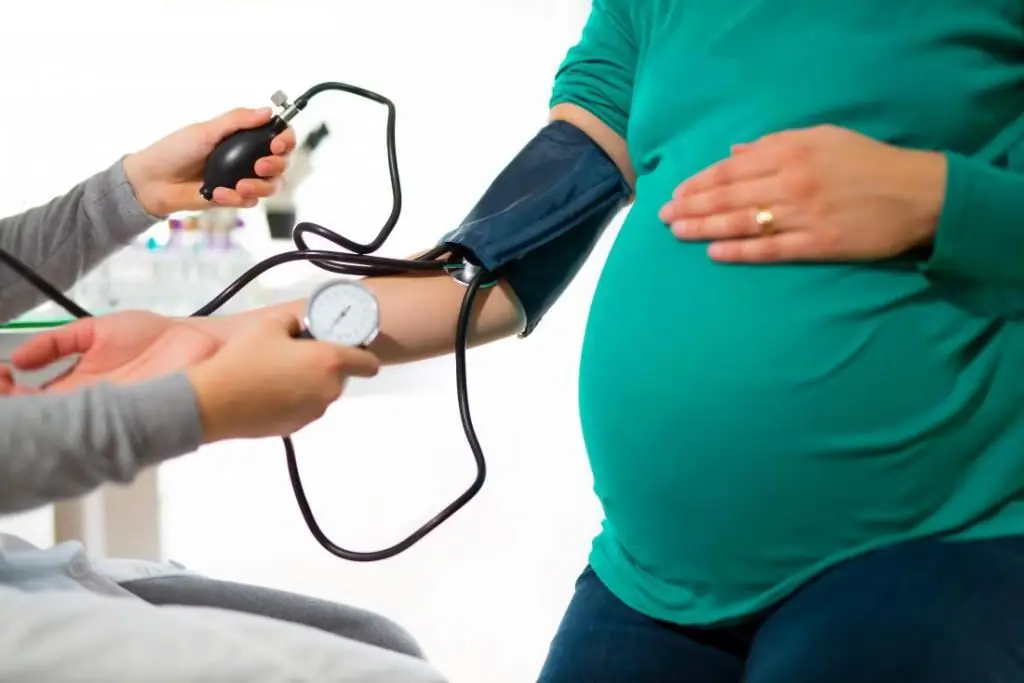2025 Author: Priscilla Miln | [email protected]. Last modified: 2025-01-22 17:55:13
A pregnant woman, having learned about the fading of the fetus, experiences a strong nervous shock. In addition, she will have to go through a long process of recovery of the body. Not surprisingly, after the experience, many women have a fear of a new pregnancy after an undeveloped pregnancy. Therefore, it is important to study the possible causes of the development of pathology and try to avoid them in the future.

Features of pathology
A non-developing pregnancy means that for some reason the embryo does not develop and dies. Pathology occurs most often in the first trimester. Fetal freezing most often occurs at 3-4 weeks, 8-11 and 16-18 weeks.
Symptoms of missed pregnancy
A woman is not immediately able to detect the problem. One of the most pronounced signs of fetal fading are spotting bloodyselection. In women, menstruation stops during pregnancy, and when development stops, the embryo no longer requires nutrition. Progesterone, which supports pregnancy, ceases to be produced in the right amount, and a partial rejection of the endometrium occurs. Fetal fading is also accompanied by the following symptoms:
- lower basal body temperature;
- mammary glands return to their previous state;
- constrictive pains;
- toxicosis abruptly stops.
Unfortunately, the child cannot be saved. A woman is being cleansed of an undeveloped pregnancy, after which she will need time to recover. The likelihood of motherhood in the future worries every woman. After a full recovery, the chances of becoming pregnant and giving birth to a he althy baby increase to ninety percent.

Causes of fetal fading
The exact causes are unknown, but it is possible to identify such factors that provoke pathology:
- drug overdose;
- surgical interventions: operations on the pelvic organs;
- bad habits;
- anatomical features: irregular uterus, fibroids, cervical weakness;
- infectious diseases that are accompanied by high fever (these include: chickenpox, rubella and others);
- Rh-conflict: Rh-negative women are more prone to developing pathologies;
- strong stress;
- immune disorders: increased blood clotting, problemswith vessels;
- genetic and chromosomal abnormalities that are incompatible with life.

Sometimes pathology appears for no apparent reason. Therefore, no one is safe from it, especially women after thirty years of age who have had an ectopic pregnancy, frequent abortions.
Examinations after non-developing pregnancy
After the fetus fades, the woman undergoes a complex curettage procedure. It takes at least six months for the body to recover. Most women are able to become pregnant after an undeveloped pregnancy in 80-90% of all cases, normal gestation is possible, followed by the birth of he althy children. But if the cases of fetal fading were repeated two or more times, then both parents need to undergo an in-depth examination at the clinic.

After an undeveloped pregnancy, the doctor may prescribe:
- get a pelvic ultrasound;
- take an analysis for partner compatibility;
- detect the level of gocysteine, autoantibodies and rubella antibody titer in a woman's blood;
- examine the level of thyroid hormones;
- take a vaginal swab for infections;
- make a histological analysis.
Menstruation after miscarriage
Fetal fading is a moral and physiological shock for a woman. Even when the embryo is rejected spontaneously due to defectsdevelopment, hormones fail in the body. Curettage refers to a surgical intervention that can cause complications. Even a well-performed procedure leads to a jump in hormones in the blood.
Menstruation has the function of updating the uterine mucosa. But after scraping, the body needs some time to recover. In the absence of complications, new periods will occur 30-45 days after cleansing, a maximum of 2 months. Time depending on the age of the patient and the term of the interrupted pregnancy.
Small highlights may appear earlier. A woman may confuse them with the onset of menstruation, but most likely this is the result of healing of the injured surface of the uterus. The discharge should not be profuse, and also accompanied by acute pain and an unpleasant odor. These signs may be signs of infection, so you should seek medical attention immediately.
When can I plan a pregnancy after a missed pregnancy?
A woman's body needs some time to recover. The interval between pregnancies depends on the period at which the fetal fading occurred. On average, a woman needs from 6 to 12 months. During this period, she must undergo a complete medical examination to identify the causes of the pathology. This is important to prevent relapse.

Physiologically, a woman can become pregnant almost immediately, so it is important to monitor contraception during this period. In the first 3 months she hasincreased risk of developing pathology in a child. And also during gestation, such deficient conditions as anemia, hypovitaminosis, hormonal disruptions, and decreased immunity can develop. But there are exceptions when, after an undeveloped pregnancy, you can become pregnant and give birth to a he althy child at an interval of less than 3 months after curettage.
Fetal fading after IVF
The largest percentage of non-developing pregnancies occurs as a result of artificial insemination. Most often this happens before 8 obstetric weeks. At the same time, the woman does not feel any signs of an undeveloped pregnancy. After IVF, she may feel low energy, mood swings, and fever.
Fetal fading after such a procedure occurs in 10-15% of cases. The doctor usually warns the woman about the possibility of failure. Depending on the term of the termination of pregnancy and the he alth of the patient, the recovery period can last up to 1 year.
Since artificial insemination may not be successful, the eggs left after IVF, ready for implantation, are frozen and can be used for re-fertilization. They can be stored for up to 5 years. According to statistics, cryotransfer after a pregnancy that does not develop in the early stages is completed successfully.
Restoring the body with folk remedies
The fading of pregnancy is a heavy stress for a woman's body. Therefore, it is important to restore it as much as possible during rehabilitation. To do this, you can use folk remedies:
- Upland uterus. Afternon-developing pregnancy helps to solve a number of problems with reproductive function in women. It can be consumed as a tea with the addition of honey and lemon. Stop taking it when you become pregnant as it can be harmful if you do so.
- Red brush. The herb has a positive effect on the female reproductive system. But it can not be taken together with hormonal drugs, during menstruation, during pregnancy. She is able to cure infertility, and colpitis and erosion are treated with douching.
- Sage. Take the herb before planning pregnancy. It helps to normalize the thickness of the endometrium, promotes the maturation of follicles, improves the functioning of the ovaries. The course of treatment takes about 3-4 months.
What drugs can be prescribed?
After the curettage procedure, the doctor may prescribe "No-shpu" to reduce pain and prevent the accumulation of blood clots in the uterine cavity. The doctor may prescribe antibacterial drugs, among which the most common is "Genferon". After an undeveloped pregnancy, it is used to prevent infection from entering the body and speedy recovery.
In case of severe uterine bleeding, oxytocin injections are prescribed. On the 14th day after the curettage procedure, the woman should be examined by a gynecologist and on the 10th day, an ultrasound should be done.
Doctor's actions after detection of non-developing pregnancy
In each case, the methods of treatment will be different. Sometimes the doctor can waitwhen a woman naturally decreases the level of placental hormones and spontaneous miscarriage occurs. But this tactic is used only in the early stages. If this does not happen, then the doctor prescribes special drugs. Their action is aimed at stimulating miscarriage. But they can only be used until the second month of pregnancy and under medical supervision.
The most common is inpatient surgery:
- vacuum extraction - the procedure is carried out using a special vacuum pump;
- curettage - curettage of the uterine cavity, which is carried out in late pregnancy.

After the procedures, the woman undergoes antibiotic therapy. To restore the body, the doctor may prescribe vitamin complexes and drugs to strengthen the immune system.
Prevention of missed pregnancy
To avoid a recurrence of pathology, a woman should lead a he althy lifestyle, avoid stress, hard physical work. This will contribute to the speedy recovery and he alth promotion in general. She must also adhere to the following guidelines:
- Preparing for pregnancy in advance. To do this, she must pass all the necessary tests and ultrasound.
- Take prescribed hormonal drugs to support a new pregnancy.
- Do not come into contact with dangerous poisonous chemicals. Take medication only after consulting a doctor.
- On the offensivepregnancy after a non-developing pregnancy, the expectant mother should try to avoid large crowds of people. This will help to avoid infectious diseases that are transmitted by airborne droplets.

So, fetal fading can occur in any expectant mother. But most at risk are women after 30 years of age who often have abortions, who have had infectious diseases, after IVF. A second pregnancy after a non-developing pregnancy should occur no earlier than 6-12 months later. It is important to remember that the next attempt in 80-90% of cases ends in the birth of a he althy baby.
Recommended:
How many days can I get pregnant after my period? How fast can you get pregnant after your period? Chances of getting pregnant after period

Pregnancy is a crucial moment for which every woman wants to be ready. To determine the probable moment of conception, it is necessary to know not only the time of ovulation, but also some features of the human body
Hypotension during pregnancy: possible causes, symptoms, treatment, normal pressure during pregnancy, advice and recommendations from a gynecologist

What is hypotension during pregnancy? Is it a simple ailment, or a severe pathology that requires immediate medical attention? That is what we will talk about today. During the period of bearing a baby, every woman is faced with various ailments, because the body works "in three shifts", and gets tired in order. At this time, chronic diseases are exacerbated, and "sleeping" ailments are awakened, which could not be suspected before pregnancy
Headache during pregnancy: causes and treatment. Cure for headaches during pregnancy

Headache during pregnancy is a fairly common occurrence in expectant mothers. According to statistics, every fifth woman suffers from it. Pain can be a symptom of a wide variety of pathological conditions, but then its characteristics will be different. Of great importance for the diagnosis of diseases is the nature of sensations, their localization, duration, conditions under which they arise, weaken or intensify
Sinusitis during pregnancy: treatment, causes, symptoms of the disease, diagnostic tests, rules for taking drugs and preventive measures

During pregnancy, a woman's immune system is greatly weakened, she is more prone to colds, a common consequence of which is sinusitis (inflammation of the sinuses). Treatment of sinusitis during pregnancy should be safe and complete, and most importantly - effective. If the first symptoms of the disease occur, you should not hesitate, as nasal congestion and the presence of pus can adversely affect the he alth of the baby
Pregnancy and epilepsy: causes, symptoms, first aid for a sudden attack, pregnancy planning, necessary treatment and strict medical supervision

Epilepsy is considered a rather serious disease in which there is a violation of the central nervous system. Such an ailment imposes certain restrictions on patients in life. For this reason, many women suffering from this disease are interested in whether pregnancy and epilepsy are generally compatible. After all, everyone wants to give birth to a strong and he althy child, even despite the fact that such an unpleasant diagnosis was made

